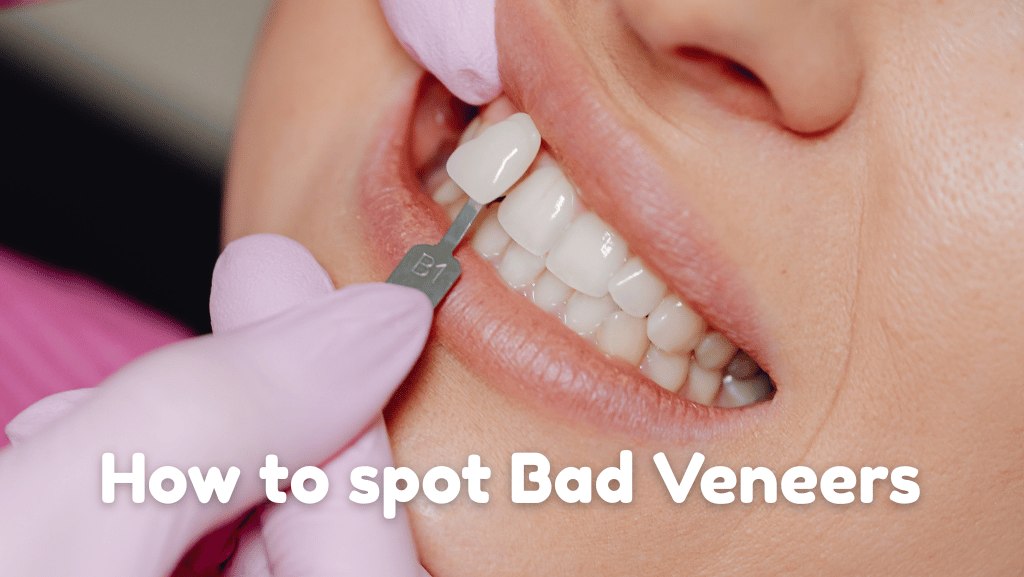For the most part, veneers are applied perfectly with no signs of damage or poor fits. But in some cases, you can get bad veneers, and spotting them is crucial to ensure you get them fixed immediately. If you leave bad veneers for too long, they can cause further issues and impact your ability to speak or eat. Issues like cracked or chipped veneers, gum swelling, and leaks on your gumline are all signs of bad or poorly fitted veneers that require immediate attention. Eating with pop on veneers should also be pain free and effortless.
Today, we walk you through all the signs of bad veneers you should look out for and what to do if you spot any of them!
Pain or discomfort
One of the most common signs of bad veneers is feeling any pain or discomfort. When installed correctly, veneers should be painless and comfortable. You should not find it difficult to chew, bite, or speak. Any pain or discomfort when doing these activities can be a sign that your veneers are misaligned or too thick.
When veneers are placed too close to the gumline, there can be inflammation and irritation, which will also cause pain or discomfort. Take note of where your veneers are placed, and speak to a dentist if you think yours are too close to your gumline.
Stained veneers
Porcelain veneers are stain resistant, so if you notice any stains or discolouration, speak to your dentist. Veneers can become stained if they are not cared for properly, so make sure you follow your aftercare guidance to prevent any stains on your veneers.
Unnatural appearance
Veneers that do not look natural can be a sign that they have not been fitted properly. Typically, veneers that give an unnatural appearance will be too big for your smile, making it seem like your mouth cannot close around them. They might also be too bright for your complexion, or too small for your teeth, making it obvious they are not your natural teeth.
Veneers that look opaque or flat can also give the impression of fake teeth and will stand out against any natural teeth in your smile.
Leakage on your gumline
If your veneers are not properly sealed to your tooth, they can leak onto your gumline. Here, bacteria can grow under your veneer, causing irritation and decay. If your veneer hasn’t been sealed correctly, you might experience sensitivity along your gumline or discolouration on your veneer. These can be signs of a leakage, and you should seek advice from your dentist.
Gaps or margins
Gaps between your teeth and veneers are a sign they are not fitted properly. These gaps and margins can cause health problems too, as food can become trapped in the gap and be difficult for you to remove. This can cause bacteria to grow, increasing your risk of tooth or gum decay, leaving you with long-term health implications.
Cracked or chipped veneers
Veneers are designed to be durable, but on occasion, they can crack. Cracks or chips in your veneers can be caused by poor quality materials or incorrect placement. When veneers chip or crack quickly after being placed, it can be a sign that they have not been installed correctly.
Teeth grinding can also cause chips or cracks in your veneers. Despite being durable, porcelain veneers can crack and become chipped if you grind them daily. A custom nightguard can help to prevent this and you can work with your dentist to address the underlying cause of your teeth grinding.
Misalignment or poor fit
Veneers that are not fitted correctly can also be a sign of poor veneers. Poorly fitting veneers can present as misaligned teeth, crooked teeth, or veneers that do not sit in the natural contour of your teeth. This can be uncomfortable and also leave you with long-term damage to your jaw and teeth.
Poorly fitted veneers can also cause temporomandibular joint (TMJ) disorders. These can become a serious issue if not addressed, so speak to your dentist immediately if you think your veneers are misaligned or poorly fitted.
Gum swelling or recession
When veneers are not placed correctly or do not fit properly, they can cause gum recession, swelling, or bleeding. Your gums can feel painful and even pull away from your teeth. Gum recession can allow room for bacteria to grow in the gaps between your teeth and veneers, causing gum disease.
What to do with bad veneers
If you have bad veneers, the first thing to do is speak to a dentist. You will want to speak to an experienced cosmetic dentist who can discuss your symptoms and perform a full examination of your teeth and mouth. With the help of a dentist, you can explore your options to see how the issue can be addressed. This might involve fitting a new set of veneers and ensuring the custom shells are a better fit for your teeth. If you have composite veneers, the resin may be reshaped and adjusted without needing to be replaced.
Find your cosmetic dentist today
When you suspect your veneers are not installed correctly, you should seek immediate help from a professional. Gorgeous Smiles is a team of experienced cosmetic dentists who can help you achieve the perfect smile and address any concerns with your veneers. Contact Gorgeous Smiles to see an expert specialising in porcelain veneers and get the smile you want today.




